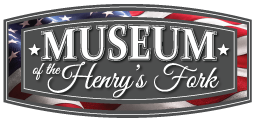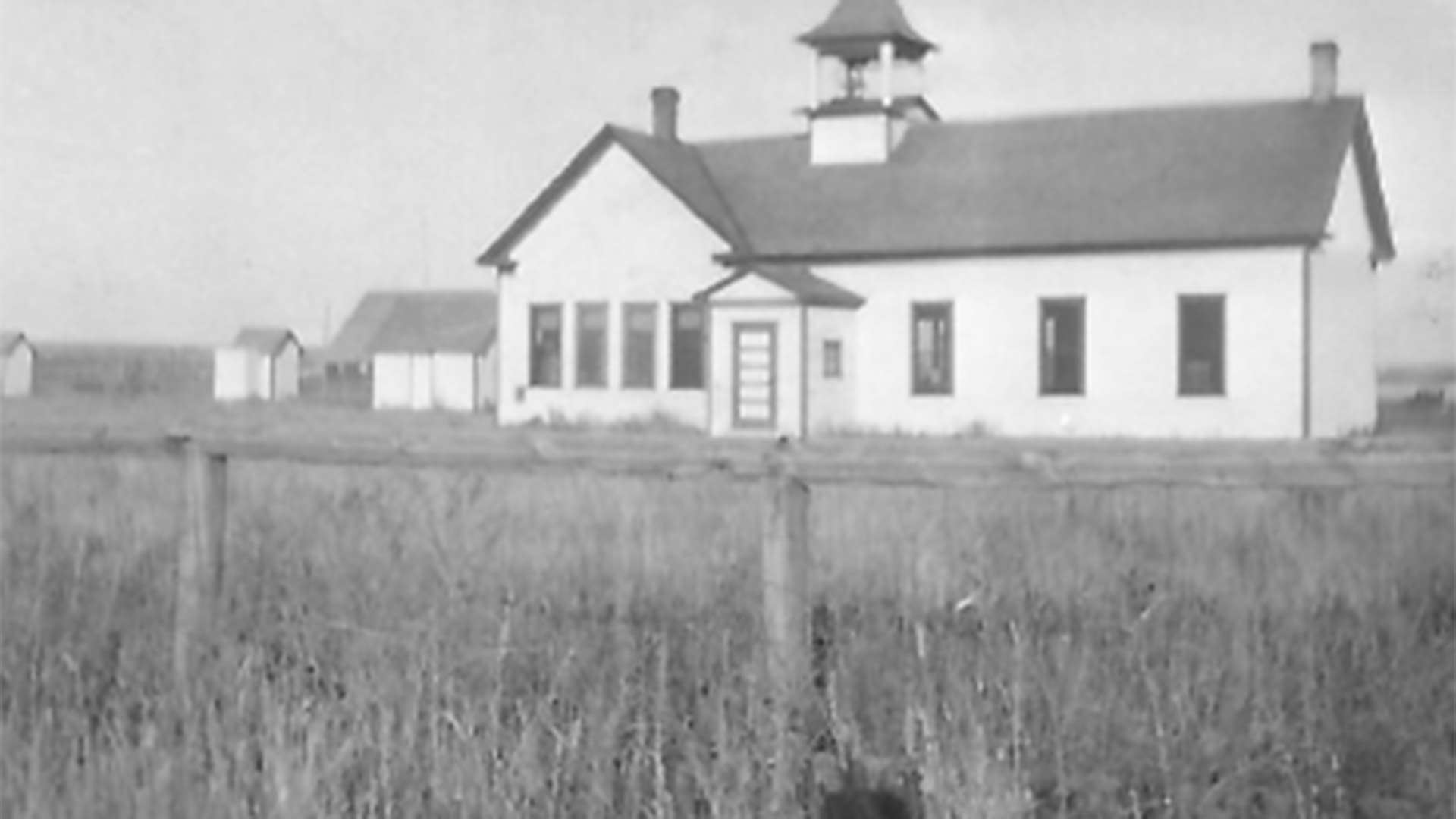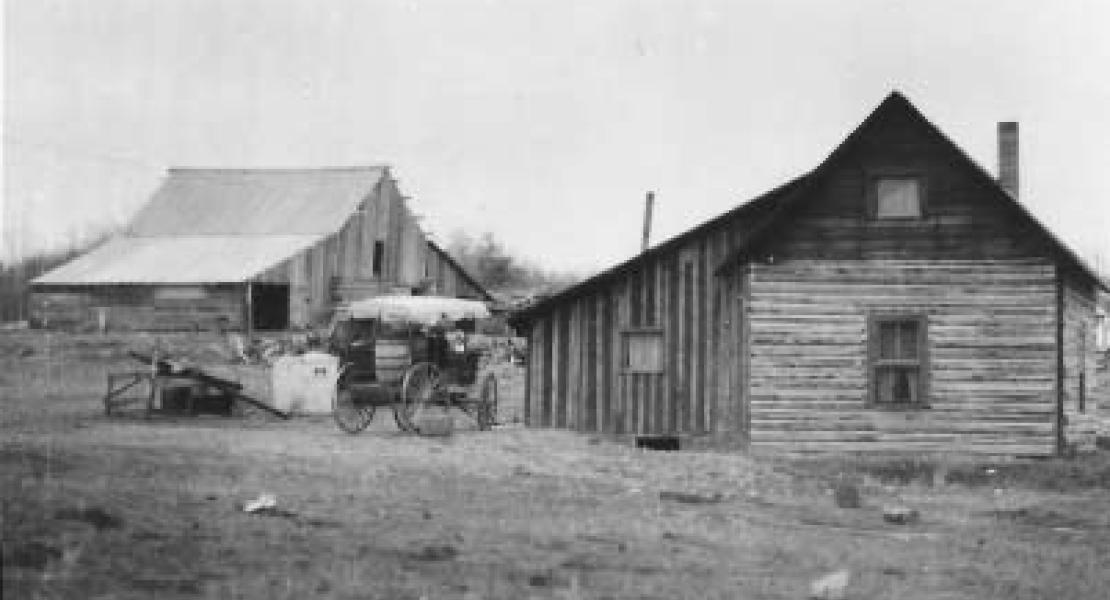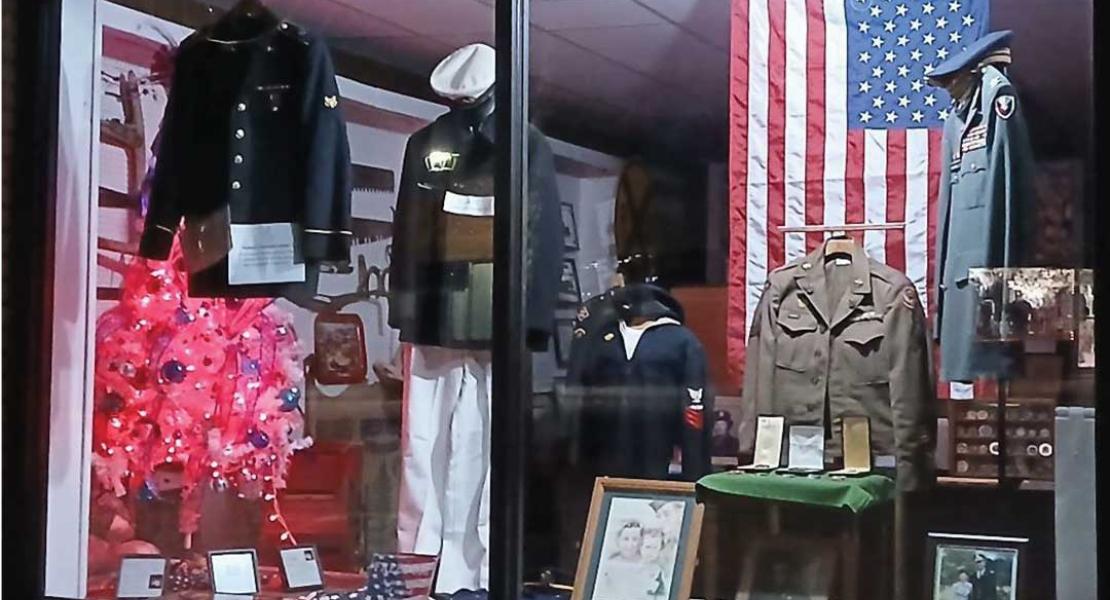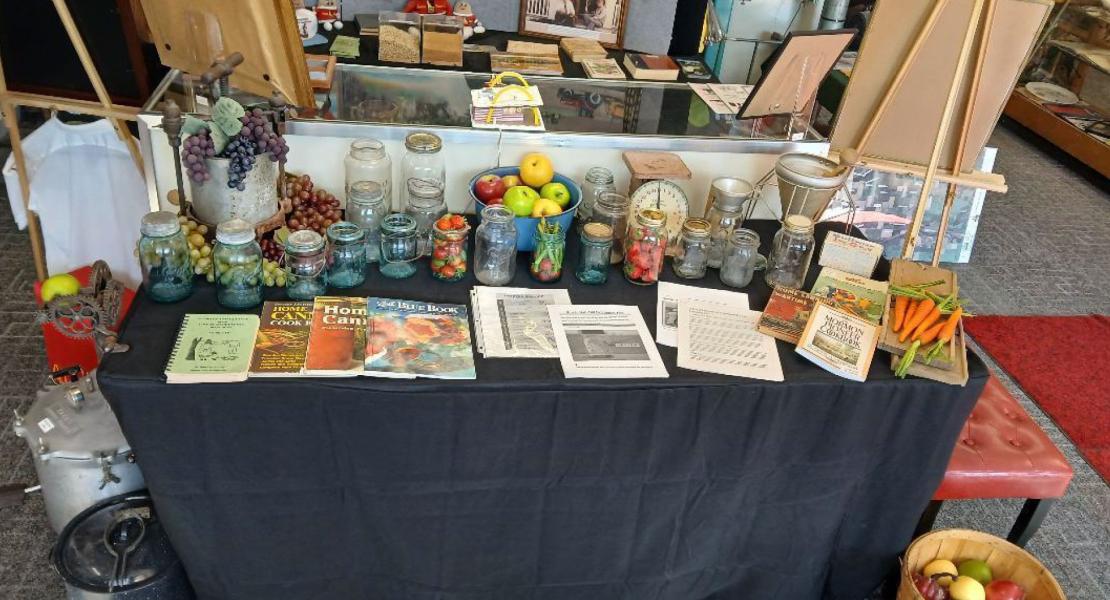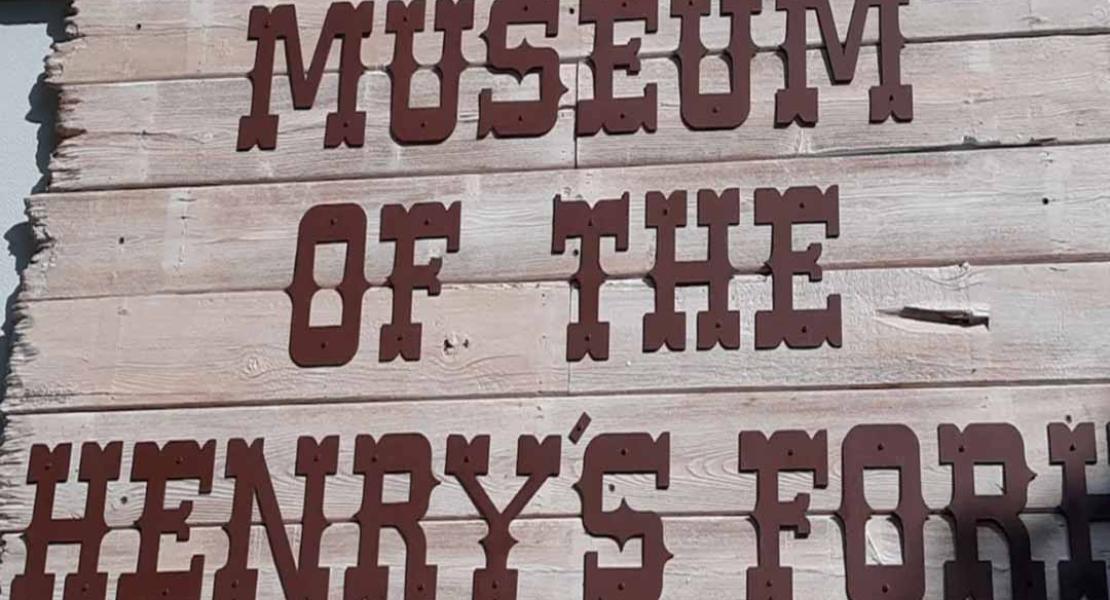Written and Compiled by Michael Fred Grube
Green Timber is a small farming community 7 miles east of Ashton, Idaho. Most of Green Timber follows the path of the Cave Falls Highway (1400 N). Green Timber's west boundary lies on 4200 east( Township 9 North Range 44 East of the Boise Meridian). The south boundary follows Falls River, and the northern boundary follows Robinson Creek. The actual location of the east boundary is unknown, but it is most likely at the most eastern privately owned land, which is known as Rock Creek Girls Camp, before Yellowstone National Park.
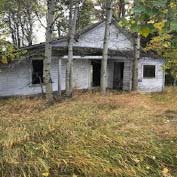
Old house on Kraemer Homestead

Lutch Cabin with John Lutch
Both photos courtesy of the Grube Family.
On June 3, 1899, Ernest Cordingley became the first homesteader to file on land in Green Timber. He settled at the intersection of the Cave Falls Highway(1400 N) and 4200 E. He was born in Monroe, Sevier, Utah on April 28, 1874. He then moved to Marysville, Idaho before choosing to settle in Green Timber. Ferdinand Kraemer and his dad Henry came from Nebraska by way of Jackson Hole, Wyoming. With only a cattle trail to follow, they headed up the pass from Jackson Hole to Victor, Idaho using a block and tackle to get to the top. The journey was slow as trees had to be hewn from their pathway and it took them a week to reach the top. Once on top, they cut a large tree 14 inches in diameter at the base, leaving the limbs from four to six inch stubs. They hitched the tip of the tree to the back of the wagon and came down the pass with all four wheels rough locked and with Henry riding the tree. (rough lock is where they would secure the wheels so they would not turn, acting like brakes) In some places they had to use the block and tackle to lower the wagon. From Victor they went to Green Timber and located a homestead near Porcupine and Rock Creek. They then headed to Blackfoot, Idaho and filed on the homestead on August 24, 1899. They meet a couple of guys in a light buggy at the top of the pass, who were surprised to see a large wagon on top.
The Kraemers never told the guys that they had used a block and tackle to get to the top. Ernest Cordingley was a rancher and the Kraemers were the first ones to plow sod in Green Timber.
Before Green Timber was settled, the ranchers from Rexburg, Idaho pastured their cattle here in the summer. As a boy, Alvin R. Nichols from Independence, Fremont County, Idaho (Today this place is known as Thornton, Madison, Idaho) would come to this area and herd cattle in the summer. There was no herd law and there were no fences, so one of the first roads started at Marysville headed north-east through the sagebrush to the draw that comes from Warm River in TWP 9 North, Range 43 East, Section 14. It then followed this draw east through sections 19, 20, 29, 28 and 21 in TWP 9 North Range 44 East, and on to the Forest. A second road followed the Falls River.
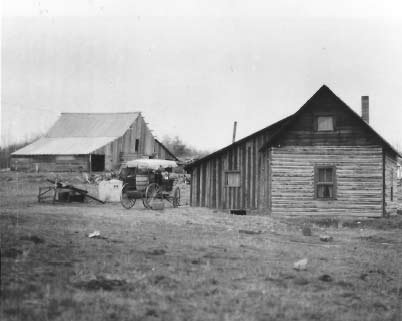
Nichol’s Homestead; Photo courtesy of Curt Stegelmeier.

John George House;Photo courtesy of Thomas Howell
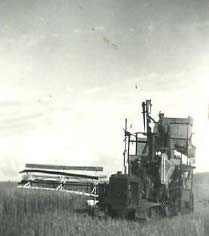
Grube’s cutting grain 1942;Photo courtesy of Grube Family
The early homesteaders had to build fences to keep the cattle out of their fields, so the road was moved to follow section lines. A year round herd law was finally placed in Green Timber. The main road was started in 1903 with eight head of horses pulling a road grader going up present day 1400 N, with a strip of land on each side of the section line dedicated by public use as a public road. They went as far as the future site of the Green Timber school the first year, present day 4400 East. In 1932, the State of Idaho bought ground to widen this road. On September 21, 1932, the state bought 4.323 acres from Perry and Sophia Grube for $1 to widen the road, thus making a total of 9.069 acres from the Grube property for State Highway 47. In 1957, the State of Idaho deemed that State Highway No. 47, extending from State highway 191(todays highway 47) to the Idaho-Wyoming state line, did not have the characteristics of a state road and was removed from the state highway system. Fremont County agreed to assume responsibility for the road if the state fixed and paved the road, which started in 1955. Before the paving took place the State put a car counter across the road and Henry Goebel(from Warm River) spent a day going back and forth across the counter because he thought if there was not enough people using the road the State would not pave it. The county took a Prescriptive Easement of 30 feet on each side of the centerline. The road became known as Cave Falls Highway 1400 N. They started keeping this road open year round in the early 1940's. Most residents of Green Timber, along with their horses or tractors, were employed with the construction of the Cave Falls road. One year the state had a requirement that part of the road work had to be done with horses. That summer, Perry Grube would sit on the hood of a truck and drive his team(without ever hooking them up)to meet this requirement.
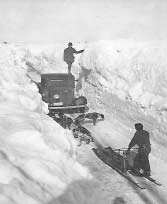

Cave Falls Road spring 1936 and Grube horse’s breaking road to Ashton 1928; Photos courtesy of Grube Family
School in Green Timber was not very consistent. Sometimes it was held in the summer, sometimes in the winter, and sometimes not at all, and always revolved around farming. The first school held in Green Timber was at the Gottfried Reimann home in 1903. It was a German Lutheran school and they had one room in the house just for this and that is also where the teacher slept. The kids were taught German and the older kids (13 and 14 years old) would also take Confirmation class. Most of the kids came from across Falls River and would live with the Reimanns during the school year. Both Pearl Fisher and Carl Lindsay taught at this school. In 1905, the Green Timber School District 72 was established with school starting that Fall in Perry Grube's homestead cabin. In 1906, the one room school house was built with lumber hauled from the Porcupine Ranger Station with school starting there in 1907. Over the next few years a barn and wood shed were also built. The first teacher for the newly formed school held at the Grubes’ was Kate Gallagher. She spoke only English, and her students only spoke German. While having summer school at the Grube home, Henry Reimann said he saw their cattle coming down the road and he left school to herd them home. While the Grube Cabin was being used for the school house, Perry kept his machinery there. One day while working on said machinery, he lost his tobacco, so Miss Gallagher let the kids out of school to help him find it. In 1912, the north room and a belfry was built and there were 36 kids attending the school from 4 families. Kids could only go through the eighth grade in Green Timber. If they wanted a higher education, they had to go to Ashton. In 1948, District 72 was consolidated with Fremont County School District 215. First through sixth grade still went to the Green Timber School, while seventh through twelfth were bused to Ashton. The school was heated with a big potbelly stove until 1948, when a basement was dug under the north section for a new coal furnace. Ninth grade was held for one year at the Green Timber school with Ben Goebel and Ralph Hossner in attendance. One spring, the water was over the bridge in the draw west of the school, so John Collier, who was working for the Grubes, would meet the kids there and help them across. The last year school was held was 1952. The horse barn was split into three sections with the Grubes, Hossners, and Stegelmeiers each taking a section. The flagpole was moved to the Ashton school. When the Green Timber school house was built, the school district thought they got an easement right for one acre of ground from James King to build on. It was assumed that each time the King farm was sold that ownership of the acre went to the new owner. In 1916, when James King sold his farm to R.I. Renkin, the deed did not transfer ownership of the acre to Renkin. Instead, it deeded it to the School District, but did not specify the Green Timber School District. When Fremont County School District 215 consolidated the county schools, they did not get a deed for the Green Timber school or the ground. The Green Timber School has gone since 1916 without an owner. In 1970, the 300 lb bell was stolen, returned three years later, only to be stolen again in 2004, and is still missing today.
The teachers who taught at the Green Timber School were:
- 1905-09 Kate Gallagher
- 1909-10 Grace M. Taylor
- 1910-11 Irene E. Stone
- 1911-12 Rolla Carico
- 1912-13 Carl Catron
- 1913-14 Lyda Pfoiffer
- 1914-15 Phoebo D. Bradbrook
- 1915-16 Louise Griffin
- 1916-17 Ruth A Vibrans and Miss Anne Bispham
- 1917-18 Ruth Whittet and Anne Bispham
- 1918-19 Unknown(School may not have been held)
- 1919-20 Louise Bradbrook
- 1920-21 Mrs. M.C. Hummell
- 1921-22 Mary Nave
- 1922-23 Libie Makonskey
- 1923-24 Ethel Morris
- 1924-26 Agnes Eichinger
- 1926-28 Hazel Duke
- 1928-29 Myrtle Anderson
- 1929-30 Lucile Baldwin
- 1930-32 Gertrude Strong
- 1932-33 Lois Thomas
- 1933-34 no school
- 1934-35 Yoland Tinsley
- 1935-37 no school
- 1937-38 Irma Dietrich
- 1938-41 Jennie Phillips
- 1941-42 Verda Cook
- 1942-43 Justiena S. Schrenk
- 1943-44 Treva Lower
- 1944-45 Hazel V. Jewell
- 1945-50 Elizabeth Whittle
- 1950-51 Thelma Weber
- 1951-52 Evajean Hill
These teachers usually stayed with one of the Green Timber residents during the school year, and some stayed and married the young men of Green Timber. Irene Stone of Green Timber went away to take teacher training and returned to teach at Green Timber, and had over 60 students. One time when A.C. Nichols(Nick) was in the first or second grade, a bad blizzard came up. The blizzard scared the new teacher and she would not let him go home. While the teacher was next door making arrangements for Nick to spend the night, he left for home. He only got part way home when he fell over a snowbank, breaking his toe strap. Nick had plenty wine leather, a leather punch, and a pocket knife to fix his ski, but it got too dark and he was unable to fix it. Nick tried to ski with the broken ski, but kept falling off. The snow was too soft and deep to walk in, so he laid down and went to sleep right there. In the morning, he fixed the Ski and went the rest of the way home.
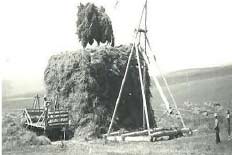
Grube’s Haying 1942
Photo courtesy of Grube Family

Stegelmeier’s picking potatoes
Photo courtesy of Loren Stegelmeier
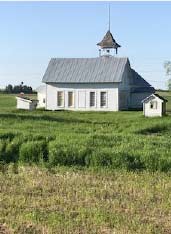
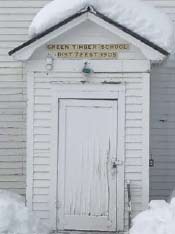
Green Timber School House; Photos courtesy of Grube Family
The school house was used for church on occasion by the Methodist and Lutherans because there was not a church building in Green Timber. The school also was the hub for community meetings, elections, etc. Quadrille and square dances were held with Pete Lief and Ralph Stevens playing fiddles and Mrs. Charles Colwell on the piano. Frederick Hossner and Perry Grube feuded for 20 or more years about school district 72. Fred and Perry were still not talking when Fred died.
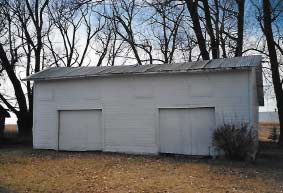
Grube section of the horse barn from the Green Timber School; Photo courtesy of Grube Family
Jim King, one of the early homesteaders, was the first mail carrier and delivered the mail from Marysville to the Green Timber Post Office. The Green Timber Post Office was started in
1906, with Johnny George appointed as the first Postmaster on April 27, 1906. The post office was in his home. The community sent a few names for the post office to the government, and they chose the name “Green Timber Post Office.” When Johnny George's wife died in 1910, Fred Hossner became the next postmaster, moving the post office to his house. The Green Timber Post Office closed in 1912.
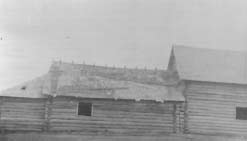
Goebel/Stegelmeier Cabin
Photo courtesy of Grube Family

Reimann Homestead
Photo courtesy of Reimann Family
Perry David Grube had the first one bottom riding plow in Green Timber, a big step in technology. Joseph Hollis Egbert had the first threshing machine in the area, and it was horse powered. They would hook eight horses to the thresher and would go around in a circle to power the threshing machine. It took about 15 men to run a threshing machine: eight bundle haulers, two or three grain haulers, one water monkey( he hauled water for the steam engine), one separator man, and one engineer. The wives of the farmers whose grain was being threshed would feed the men three times a day. Steam powered threshing machines took the place of horse powered ones. The Grubes, Reimanns, Stegelmeirs, and Kraemers all had threshing machines that they did work with for other farmers. They got paid by the bushel at 3 cents for oats, five cents for wheat, and 8 cents for peas. The farmer would use a hand scythe, or horse drawn binder, to put the crop in bundles. They would start threshing as soon as they could in the Fall, and most times did not finish until Christmas. After Christmas, the neighbors would work together to haul their grain to market using teams and sleighs. By the late 1940s, most farmers were using pull type combines which cut, threshed, and put the grain in a tank on the go. Self propelled combines followed and today(2018) a combine can cut 30 feet or more, thresh, and unload into a trailer pulled alongside, making it possible to harvest more grain in one hour than the first homesteaders planted.
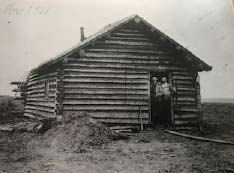
Grube Cabin: Willard Austin(Left) and Perry Grube
Photo courtesy of Grube Family

Kuehl Barn, 1947;Photo courtesy of Kuehl Family
People in Green Timber started to raise potatoes in the 1920s. They would dig the potatoes with a horse drawn digger that put the spuds on the ground. A crew would come along with baskets, or they would drag a potato sack between their legs hooked to a sack belt around their waist. When the sack was filled, they hauled them to the cellar for storage. In the spring, the neighbors would help each other haul their spuds to the railroad. They would haul the spuds with team and sleigh, hauling about 33 sacks at a time. It took about 12 loads to fill a railcar and took all day. Aurther Wakefield, who had one of the first horse drawn diggers in Green Timber, would hire out digging potatoes for his neighbors. Potato diggers went from one row to two rows, eventually being able to put the potatoes in the back of a truck. In the 1960s, they started using cross row diggers that dug two rows, putting the potatoes between two rows not dug. This allowed the main digger to harvest 4 rows at a time, greatly speeding the harvest up. Today, using several 4 row cross rows and a two or four row digger, you can dig more potatoes in one hour then the first homesteaders planted.
Every homesteader had a need for hay. They would cut grass or alfalfa using a horse drawn mower. After the hay cured, some farmers would use a buck rake, while others would load it on a wagon by hand, to haul the hay to the stack. There were different ways of stacking the hay. One way in Green Timber was the use of a derrick. The derrick was made of wood, with a long pole that would swing back and forth. Some were stationary and some were built on skids so they could be moved. A net or grapple hook would be attached to the pole with a cable so it could be raised and lowered, allowing the hay to be stacked. Then came along the stationary baler that compressed the hay into a bale. The bales were hand tied using wire and stacked by hand. Balers on wheels that would pick the hay up, compress it, and tie it on the go, replaced the stationary balers, but the hay still had to be stacked by hand. Then came along the bale wagon that would pick the bales up off the ground and stack it without anybody touching the bales. Today (2018), there are balers that make bales weighing two tons each.
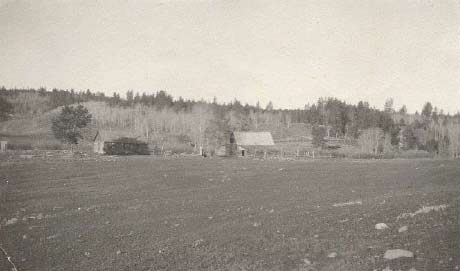
Airhart Ranch; photo courtesy of Thomas Howell.
In 1918, Perry Grube started a sawmill at Lightning Bug in section 26(where the CCC camp and Green Timber campground would be in years to come). He ran it for 5 summers, but you had to log your own logs. In the 1970s, Roy Stegelmeier ran a sawmill by his house on the CCC camp road(4500E) and Walt Grossenbachs ran a sawmill where the Timberline Golf Course is.
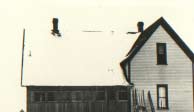
Stegelmeier Home 1912;
Photo courtesy of Lorin Stegelmeier.
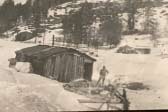
Jim Hoy Cabin
Photo courtesy of Helen Kinler
In 1908, Johanna Dora Reimann was buried in Green Timber(about one mile north on 4500 east). She thought that the closest bridge to go to the Squirrel Cemetery was too far and was afraid that if they took her body across Fall River using the cable car(cable car was replaced by the CCC bridge), that she would fall in Fall River and float away so she wanted to be buried on the high hill at home so she could see the Tetons. They buried her in the corner of the farm instead. August Goebel died in 1904, and was buried next to the Schulz baby on the south side of the Yellowstone canal between 500 and 700 feet west of 4350 East. In 1914, Otto Stegelmeier and Bill Moedl moved Augest Goebel's grave to the PineView cemetery and buried him next to his sister. The Schulz baby is still buried there and is in an unmarked grave. The first winter the John Cawford family lived here, Robert, their teenage son, cut his knee with an ax while chopping wood and died of blood poisoning. Because of bad weather, they were unable to get medical help and he died of blood poisoning.
The telephone line came in 1910, and in the 1970s they buried it. In the summer of 2016, Green Timber joined the modern world with fiber optic cables for internet. In 1938, Fall River Rural Electric Cooperative was organized and they received a loan of $80,000 in1939 to start building power lines. In the spring of 1941, the power in Green Timber was turned on.
The Civilian Conservation Corps had set up a camp up by 1935, known as the Porcupine CCC camp. It was located at township 9N range 44 E section 26. They built the CCC Camp Road(4500 East) going south off Cave Falls Highway, leading to the CCC Bridge on Fall River. This bridge was built by the CCC in the late 1930s. It was 200 feet long, had a deck width of 12.5 feet, and was the Howe pony truss design. The Bridge was replaced in 1983. It links Green Timber and Squirrel together. The CCC also helped with the construction of buildings at the Porcupine Ranger Station. After the organization was abolished in 1941, the CCC camp closed down. The old camp became the Green Timber campground and was used into the 1970s.
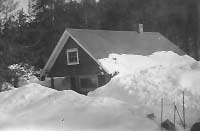
Porcupine Ranger Station
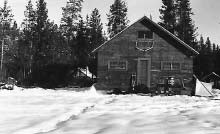
Mess Hall at J-Y Ranch
Photos courtesy of the Kuehl Family.
Most of the kids raised in Green Timber learned to swim at White Fish, which is located north of the school house on Robinson Creek. While this swimming hole is natural, it was made bigger with the aid of dynamite by early homesteaders. There was even a diving board at one time, and for the young men of Green Timber swimming suits were optional. In the late 1970s and early 1980s, several subdivisions where started, and in 1999, Carl and Bonnie Bates opened
the Timberline Golf Course.

Green Timber School class of 1912
Note:Photo taken before the north room was built;
Photo courtesy of Grube Family
As early as 1898, the need for irrigation was on the minds of area farmers. The Green Timber Ditch company was started and incorporated on November 8, 1901. Work on the ditch was started using scrapers and teams. The men were paid $1.50 per day with half in cash and half in ditch stock. The ditch would supply water for Green Timber, Warm River, and parts of Hugginsville. The Green Timber Ditch Company Limited went broke within a year. In 1902, the Yellowstone Power and Irrigation was started. The farmers were unable to finance the ditch, so The Clinton Hurt company was convinced to invest in the company and put up $80,000. On July 29, 1904, The Yellowstone Power and Irrigation Company Limited was incorporated with Abraham Hillam, L.B. Reynolds, Gottfried Reimann, Frank McGavin, and David Howell as the Board of Directors. Mr. Reimann was the civil engineer and chief foreman of the building of the YellowStone Canal. On June 15, 1905, he organized 15 men with their teams and began digging the canal with slip-scrapers. Work on the ditch was slow, but it was eventually finished about 1907. The first dam was made of wood going clear across Falls River, but did not hold up during spring run off. Eventually a new dam was built further up the river and was made by pushing up rocks and only going part way out into the river. At first, the ditch was not very consistent with only a trickle of water and no ditch rider at times. The first ditch rider was Henry Reimann. Some of the other men who were ditch riders were Chet Smith, Loren Stegelmeier, Roy Stegelmeier, Grant Bessey, James Neubauer, and Perry O. Grube, with Curt Stegelmeier as the ditch rider in 2019,(the ditch rider takes care of the ditch and controls the water). Ferdinand de Stwolinski of the Wilkie and Wyman Company came to Green Timber to survey the Yellowstone ditch. He stayed with the Stone Family where he met his wife, Irene Stone. He acquired 160 acres through the Cary Act of 1894, and eventually moved to Ashton, Idaho.
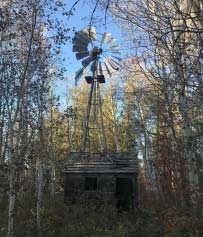
Windmill on Atkinson homestead
(photo taken in 2019)

Cave Falls
Photos courtesy of Grube Family
The Porcupine Ranger Station was established in 1905 in the Henry's Lake Forest Reserve with a log home and a log barn in section 23. With the help of Civilian Conservation Corps labor, a wood framed office building was built in 1934, a flammables storage building in 1935, a wood framed equipment shed and warehouse, shop/garage, and gas and oil house in 1936. Somewhere between 1934 and 1937, another garage was built. A new office was built in 1956, and enlarged in 1962 by adding two rooms. 1968 was the last year Porcupine was used as a ranger station. In 1972, the office was converted into a bunk house for seasonal employees. A cinder block pesticide storage building was constructed in the compound in 1978 or 1979. Forest rangers that served at Porcupine Ranger Station are:
- James R.Hanson 1905- 1909
- Mr. Poqqe 1909-1910
- Ernest Renner 1910-1915
- Ira Latham 1915-1924
- Leo Hutson 1924-1927
- G.D. Pickford 1927-1930
- M.J. Markham 1930-1935
- Ira Latham 1931-1935
- Rufus Hall 1935-1937
- Mel Coonrod 1937-1941
- Lorin Wellman 1941-1947
- Burt Rouse 1947-1951
- Dale Carringer 1951-1956
- Bob Patee 1956-1959
- Gordon Colby 1959-1964
- Frank G. Beitia 1964-1968
Targhee Supervisors;
- Homer Fenn -1908
- David Barnett 1908-1911
- Chester Morse 1911-1918
- Samuel Stoddard 1918-1934
- J.W. Farrell 1934
- Floyd Godden 1934-1936
- Sidney Scribner 1936-1938
- Miller Benedict 1938-1944
- John Kootch 1944-1945
- C.I Daugherty 1946-1950
- Grant Morde 1950-1955
- Gordon Watts 1955-1959
- Alvin Wright 1959-1969
Henry's Lake Forest Reserve was established on May 23, 1905, and became a National Forest on March 4, 1907. On July 1, 1908, the entire forest was combined with a portion of Yellowstone National Forest to establish Targhee National Forest. In 1911, The Army built Bechler Ranger station in Yellowstone Park. There were about 20 soldiers stationed there until 1916, when the National Park Service was created. Sgt. Plant, an early day Sergeant, would have the Green Timber neighbors up for dinner. The soldiers would stay with the Grubes, Hossners, Reimanns, and other neighbors when making trips to town and back.
On Sunday, March 29, 1936, Alvin Matthews went to visit his longtime friend and business partner William D. ``Jim" Hoy, a bootlegger, who lived in a remote cabin on Porcupine Creek. During the course of the day, they consumed a lot of moonshine and got into an argument in which Alvin shot Jim six times with his .30-.30 at close range. When Matthews did not return home, his son Wallace went looking for him and found him drunk, and Hoy dead. Matthews was arrested Monday morning and held in Fremont County Jail. On April 2, 1936, Matthews committed suicide by jumping off the upper bunk onto his head. He had told a fellow inmate that he knew he was guilty and did not want his grandkids going through his trial. William D. ``Jim" Hoy is buried in the Riverview Cemetery in St. Anthony, Fremont, Idaho in an unmarked grave, and Benjamin Alvin Matthews is buried in the Pineview Cemetery, in Ashton, Fremont, Idaho. Joe Branson, as well as many others in Green Timber, also ran moonshine.
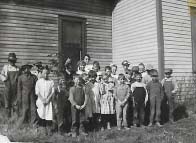
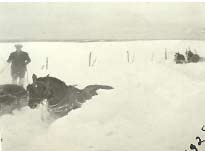
School days 1920 and Breaking road 1928; Photos courtesy of Grube Family
In June 1935, Lucile Grube, Evelyn Grube, Neola Vik, Madison Reimann, Elsie Howell, Florence Hall, and Goldie Zitting started the Green Timber Goodfellowship Club, meeting once a month in their homes. The club was a social event for the women. They took care of each other in times of need, such as deaths, births, sickness, or any time someone in the community needed a little extra help. In 1937, they started meeting in the school house and invited their husbands to come play pinochle. The club is still going today (2019), meeting once or twice a month in the winter for pinochle. The club rents the school house from Fremont School District and is in charge of maintaining it.
In 1934, John A. (Jack) and his wife Jerry Young started the J-Y Ranch and Wyodaho Boy's camp for young men on the girls camp road, just south of the present day LDS girls camp. Most of the boys, ages 13 to 19, came from New York and were Jewish. They would arrive in Ashton, Idaho on the train and hauled to the ranch in the back of a cattle truck. Once at the ranch, the boys would sit on the top rail of the corral while Jack would explain what each boy's responsibilities would be. They would then herd in some horses, and each boy would pick a horse, with the help of Jack, for the summer. Some of the horses were already broke, while others had only been ridden once. They would spend the first two weeks at the ranch learning how to take care of their horses and help with the everyday chores. They then would go on a month long pack trip in Teton and Yellowstone National Parks. The highlight of the eight week program was the end of the summer rodeo the boys participated in. In January 1950, the Yellowstone, Rexburg, and North Rexburg Stakes of the Church of Jesus Christ of Latter-Day Saints agreed to buy the J-Y Ranch for a girls camp. In October 1951, they renegotiated the sale of the ranch and only purchased 20 acres and agreed to call it the J-Y Girls camp, but a few years later changed the name to Rock Creek Girls Camp. In 1951 and 1952, Jack leased part of the buildings back to keep the boys camp going and provided horses for the girls. 1952 was the last year for the Wyodaho Boy's Camp. The camp is used during the week by the Church of Jesus Christ of Latter-Day Saint as a girls camp, and rented out on weekends to the public. In 2019, the church stopped renting it out to the public.

J-Y Ranch
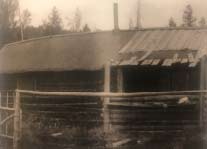
Winegar Cabin
Photos courtesy of Frank Young
On the 4th of July, the neighbors would get together for a picnic, driving with a team and buggy to one of two places; east of Stegelmeier’s or north of the gooseneck on the Yellowstone ditch, both on the forest reserve. Baseball, saddle horse races, and plenty of good food were enjoyed by everyone. In the early days, there were plenty of elk, deer, and moose, and one could shoot wild chickens from the roofs of their homes early in the morning. At one time, there was a small ski hill in Green Timber in section 22, with a makeshift rope tow for the kids to use.
Otto Stegelmeier came in the Fall of 1898 from Chicago as a camp tender and cook for a group of elk hunters. He left for the winter, and came back in 1899 with the same group and stayed for the rest of his life. He had a dugout up by Horseshoe Lake on Robinson Creek, and ran a trap line. One year, just before Christmas, he was snowshoeing out and came across a herd of elk. He shot 15 head, then spread the word to his neighbors that if they needed meat for the winter, he knew where to get it.
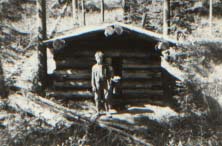
Otto Stegelmeir’s Dugout
Frank and Edward Goebel
Photo courtesy of Loren Stegelmeier
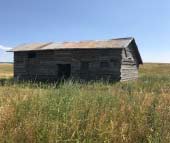
Kautz Grainery
Photo courtesy of Grube Family
When a person filed for a homestead, they did so under the Homestead Act of 1862. It was possible to switch from the homestead act to the Sale Cash Act of 1820 during the contract, which some did. The Homestead Act was usually a five year contract. Any time you bought ground from the government, you received a patent for it, instead of a deed. The Carey Act of 1894 provided the transfer of desert lands of the U.S. to western states. The State of Idaho received a patent for this ground in 1920. They then would turn around and sell it to settlers to homestead with irrigation requirements. Before Green Timber was opened up for homesteading, there was a Native American encampment, mountain men/trappers, ranchers from Rexburg, and even a few squatters all trying to make a living.
The list below is of those who filed for a homestead, and in which year they did so. It does not indicate in which year they first came to Green Timber. Some homesteaders would file, but then leave and sell their rights to someone else, who would then come and file on that homestead. Each section is listed with a number by the different splits starting in 1899 and going to 2018. “Map 1”(featured below the list) accompanies this list.
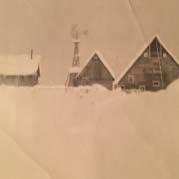
Hossner Homestead
Courtesy of Helen Kinler
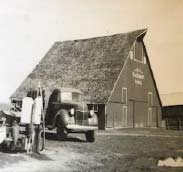
Marotz Barn
Courtesy of Sandi Bowersox
Township 9N. Range 44E. Section 15.
- Albert Stone 1911, Everett Eeseman 1912, William F. Neiland 1913, Bob Parker, Earl Harris, Oscar Malmburg, Carl Reimann, Jack Reimann, JLB Stewardship Trust.
- Albert Stone 1911, Everett Eeseman 1912, William F. Neiland 1913, L.M. Williams, Neiland Tanner, Bolter, Harry Lewis, Ron Bird.
- Henry Kraemer 1900, Otto Hargins 1902, William F. Neiland, Dora Stegelmeier, Carl A. Reimann, Jack Reimann, Robinson Subdivision.
- U.S., William D. "Jim" Hoy, Carl A Reimann, Jack Reimann. Potpourri Ranch.
- U.S., Harry Lewis, Robinson Subdivision.
- Andrew Stone 1916, Sarah M. Meacham, Neiland Tanner, Bolter, Harry Lewis .
Section 16 was a school section,
- State of Idaho 1899.
- State of Idaho 1899
- State of Idaho 1899
- R.E. Rankin, Joseph Rankin, Jack Marotz, Teton View Subdivision.
- P.D. McArthur, Alford Zitting, Mary Weber Trust and Theresa Trawick Trust
Section 17.
- State of Idaho 1899, BLM
- Ralph O Stephens, south of creek William R. George and Julia Jesperson.
- Gus Halitschke 1907, Ralph O. Stephens.
- Gus Halitschke 1907, Joe Branson, David P. Grube, Dallas Howell, William R. George and Julia Jesperson.
- State of Idaho 1899, R.E. Rankin, Herman Marotz, Jack and Nancy Marotz.
- State of Idaho 1899, Fred Nielson, Joe Branson, David P. Grube, Dallas Howell.
- State of Idaho 1899, Fred Nielson, Augest Olsen, David P. Grube, Dallas Howell, William R. George and Julia Jesperson
- State of Idaho 1899, Fred Nielson, Joe Branson, David P. Grube, Dallas Howell, William R. George and Julia Jesperson.
Section 18.
- John Martin Johnson, 1913, Fred Lewis.
- Fred Lewis 1930, Gwaltney E. C. 111
- State of Idaho 1899, R.E. Rankin, Herman Marotz, Mickie Funke and Steven Funke.
- State of Idaho 1899, Max Marotz Sr, Max Marotz Jr., Margo Smith(MCM)
- James Simons 1906, Dean Syond, Alvin Mathews, Max Marotz Sr., Herman Marotz, Mickie Funk.
- Alvin Mathews 1901, Max Marotz Sr. Emma Marotz, West 1/2 Max Marotz Jr., Margo Smith, and East 1/2 Herman Marotz, Mickie Funke
- Paul Ziems 1899, Howard D. Koon 1901, Pat Calkins 1903, Sarah A Merrill 1907, Gus Isenburg, William Moedl, Alford Zitting, Herman Marotz, Jack and Nancy Marotz.
Section 19
- Zachariah Hardy 1899, Alvin Mathews 1901, Elsie Jefferson, George Marotz, Toni Marotz, Ty and Tuk Nedrow, Jerry Funke.
- Zachariah Hardy 1899, Alvin Mathews, 1901, Elsie Jefferson, Herman Marotz, Jack and Nancy Marotz.
- Katherine Reimann and Morris Coffey 1911, Katherine Reimann, Walter Reimann, Robert Reimann.
- Gottfried Reimann and Claudius Place 1912, Katherine Reimann, Walter Reimann, Robert Reimann.
- Ernest E. Cordingly 1899, Max Marotz Sr. Emma Marotz, West 1/2 Max Marotz Jr. , Margo Smith east 1/2 Herman Marotz, Jack and Nancy Marotz.
- Hyrum W. Stolt 1899, John Albert George 1902, Harry Hudson, Goldie Zitting, William and Cheri George.
- Hyrum W. Stolt 1899, John Albert George 1902, Elmer D. George, Elsie Howell, William George and Julia Jesperson. 2.6 acer lot Thomas and Karla Howell.
- Henry Oestman 1899, R. I. Rankin, Helen M Rankin, William Maedl, Fred Corcilius, Clen and Emma Atchley
- Henry Oestman 1899, R.I. Rankin, Helen M. Rankin, William Maedl, Daniel Wilhelm Reimann, Daniel William Reimann Jr., Shirley Reimann.
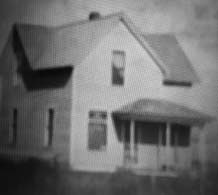
Jim King House
Photo courtesy of Helen Kinler
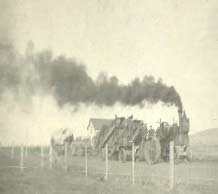
Steam engine and Threshing Machine
Photo courtesy of Grube Family
Section 20
- State of Idaho 1899, Bliss Moore, Peter Leif, Hebert J. McVicker, Leo MacKeigan, Daniel Wilhelm Reimann,Nigel and Bonn
- State of Idaho 1899, Max Marotz Sr., Carl Marotz, Marilyn Marotz Corcilius, C and L Ranch.
- James P. King 1900, R.I. Rankin, Carl Marotz, Marilyn Marotz Corcilius, Evelyn Atchley, The Green Timber School is in the North East corner.
- State of Idaho 1899, Tom Heaps, Neil Bradbrook, Carl Peterson, Charles J. Wieburg, Alford Zitting, Robert and Suzan Comstock.
- State of Idaho 1899, Fred Nielson, Duncan Mc Arthur, Dick Branson, David P. Grube, Forest Howell, Fred Corcilus, Corcilius Trust.
Section 21
- State of Idaho 1899, Ferdinand deStwolinski, Carl Marotz, Jack Marotz and Jerry Funk. Teton Subdivision.
- Anton Erpenback 1900, Henry R. Mc Arthur 1904, Owen Grube 1, Charles Powell, Frank Britton, Earl Hossner and Fred Brady, Earl Hossner and Allyce Brady, Allyce Brady and Hossner Farm LLC.
- Johann Jacob Lutsch 1900, Frederick Hossner 1909, Earl Hossner, Hossner Farm LLC.
- Otto Stegelmeier 1900, Otto Ruthardt 1902, Fred Stone 1908, Lou Train, Pearl Cordon, Earl Hossner and Fred Brady, Earl Hossner and Allyce Brady, Hossner Farm LLC.
Section 22
- Howard B. Wilson 1901, Andrew Stone 1912, Sarah M Meacham, Merle Stone, William Keaton, Carl Reimann, Jack Reimann, Robinson Subdivision.
- Ferdinand Kramer 1899, Ted Courtney, Vernon Hibler, W.L. Robinson, Walter Phillips, Carl Reimann, Jack Reimann, Kenneth Henry, Terri Harrinfeld.
- Henry Kramer 1900, Otto Hargens 1902, Dora Stegelmeier, William Nieland, Carl Reimann, Potpourri Ranch.
- Gottfried Reimann 1904, Daniel Wilhelm Reimann, Richard Reimann.
- George Kautz 1901, William Chittock, Harry Chittock, Daniel Wilhelm Reimann, Daniel William Reimann Jr., Shirley Reimann.
- Burt Kelly 1905, Everson S. Atkinson 1911, Gottfried Reimann, Daniel and Carl Reimann, Daniel Reimann, Potpourri Ranch.
- Everson Atkinson 1911, Gottfried Reimann, Daniel and Carl Reimann, Daniel Reimann Potpourri Ranch.
Section 23
- Porcupine Ranger Station.
Section 24
- George H. Airhart 1910 , Frank Burrall, Forest Howell, Dr. Duke, L J and Mary Ybarroudo Trust
Section 25
- George H. Airhart 1910, Frank Burrall, Forest Howell, Dr. Duke, L J and Mary Ybarroudo Trust.
Section 26
- Howard Koon 1901, U.S.
- Albert Parks 1902, U.S.
Section 27
- George Kautz 1901, William Chittock, Harry Chittock, Daniel Wilhelm Reimann, Nigel and Bonnie Fern, East 20 Acres Shirley Reimann.
- Hugh Park 1902, Edward A. Strong 1907, John Collier 1909, Sarah M. Meacham, Walter Grossenback, Carl and Bonnie Bates.
- William Krimin 1902, Tom Nieland, Walter Phillips, Bernans, Jim Osborne, Frank and Louis Stegelmeier, Roy Stegelmeier, Curt and Britney Stegelmeier.
- Clay C. Nichols 1909, Aaron Porter 1914, Jim Osborne,Otto Stegelmeier, Frank and Louis Stegelmeier, Roy Stegelmeier, Curt and Britney Stegelmeier.
- Burt Kelly 1905, Emil Victor Sheer 1907, Alvin Ray Nichols 1908, W.W. Speir, Frank and Louis Stegelmeier, Roy Stegelmeier, Curt and Britney Stegelmeier with Cathy Stegelmeier Subdivision.
Section 28
- George Kautz 1901, Lousia Kautz 1903, Perry D. Grube, Owen P. Grube, Perry O. Grube, Michael Grube, East 50 acres Grube Family Lots.
- Sophia Kautz 1902,Sophia Grube, Owen P. Grube, Perry O. Grube, Jeffry O. Grube, North 1/8 Michael F. Grube
- Jacob Kautz 1902, Sophia Kautz Grube, Owen P. Grube, Perry O. Grube, Jeffry O. Grube, North 1/8 Michael Fred Grube.
- Frederick F. Larmer 1903, William Kirkam 1906, James Ross 1909, Neil Bradbrook, William Goebel,Otto Stegelmeier, Frank and Louis Stegelmeier, Roy Stegelmeier, Curt and Britney Stegelmeier.
Section 29
- Willard J. Austin 1901, Joseph Thompson 1904, Otto Stegelmeier, Louis Stegelmeier, Roy Stegelmeier, Curt and Britney Stegelmeier.
- Perry D. Grube 1901, Owen P. Grube, Perry O. Grube, Mike Brown, Craig Jensen, North East corner Michael and Kathyrn Grube.
- Dora R Goebel, Dora R Stegelmeier, 1903, Frank and Louis Stegelmeier, Roy Stegelmeier, Curt and Britney Stegelmeier
- Otto Stegelmeier 1902, Dora Stegelmeier 1906, Ben Owen 1909, Aurther Wakefield 1911, Otto Stegelmeier, Frank Stegelmeier, Roy Stegelmeier, Curt and Britney Stegelmeier. 10 Acer lot Frank Stegelmeier,Tom Stegelmeier and then Tyler and Brenda Cude.
- Abraham B. Hilliam 1904, James Wood 1908, Ben Owen 1909, Aurther Wakefield 1911, Otto Stegelmeier, Frank and Louis Stegelmeier, Roy Stegelmeier, Curt and Britney Stegelmeier.
Section 30
- Perry D. Grube 1901, John Crawford 1905, Alma Woods, Caroline Sanders, Carl Marotz , Marilyn Marotz Corcilus, Clen and Emma Atchley.
- John Albert George 1901, Julia Moriarity George 1905, Harry Hudson, Carol Bessey, Jason Howell, lot on north Helen Bessey.
- John Albert George 1901, Julia Moriarity George 1905, Mary George Ney, John and Deborah Ney.
- Oval Harris 1912, Alma Woods, Caroline Sanders, George Marotz Farms.
- Frank Garbe 1899, Ernest Kuehl, Eric Kuehl, Mark Kuehl.
- William Schulz 1899, Max Marotz Sr., Emma S. Marotz, Victor Marotz, North East corner Jeff and Jeremy Marotz.
- John Albert George 1901, Julia Moriarity George 1905, Harry Hudson, Goldie Zitting, William and Cheri George.
Section 31
- Sam J. Currgham 1902, James B. Cutlett 1904, William L. Sharp 1905, Alice Atchley, Alonzo Atchley, Bill and Lon Atchley, Clen and Emma Atchley.
- John P. Atchley 1904, Alice Atchley, Alonzo Atchley, Bill and Lon Atchley, Clen and Emma Atchley.
Section 32
- Gus Halitschke 1910, Emma Halitschke 1914, Glifford Brown 1917, Bruno Albert 1925, M. Fried, Alonzo Atchley, Bill and Lon Atchley, Clen and Emma Atchley.
Section 34
- John Edmonson 1910, Ben and Rudolph Senior, Earl Griffel, Doug Griffel.
- William H. Loomis 1907, Walter Lenz, Norbert Lenz, Wayne Lenz on west end and Fremont Co, Gravel pit.
Section 35
- Hugh D. Kelly 1901, Elmer Duke, Marysville Ditch Co.
- Clark W. Orton 1901, Reade M. Irland, Glen Davis Trust.
- Malcalm Nichols 1914, Alonzo Perry 1919, BLM.
- Reade M. Irland
- Reade M. Irland
Section 36 - School Section, State of Idaho.
- Walter Phillips Family, Bill Robinson, Fall River Ranch LLC.
Township 9N, Range 45E, Section 17. no map since there were only two homesteads.
- John Harlow Hendricks 1925, George Nedrow, U. S.
- Willis L. Wineger 1909, Thomas B. Sheffer, Joseph Hallis Egbert, John A. Young, Wells Barney, Blair Calaway Family. The girls' camp came out of this ranch in 1950.
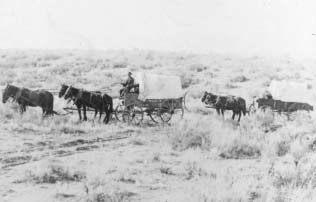
Perry Grube (on wagon)coming to Green Timber with Willard(Bill) Austin and Johnny George;Photo courtesy of Grube Family
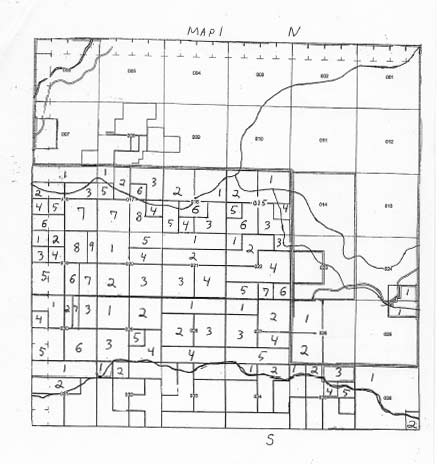
Regarding the creation of the Green Timber History
In 1975, a group composed of the children of homesteaders and their spouses, headed by Owen and Lucile Grube and A.C. (Nick) and Leah Nichols, met at the Grube home and started this Green Timber History. They had Don Marotz make a map of Green Timber which Nick picked up on his way to the Grube home for the meeting. This history was finished in 2019 by Michael Fred Grube(Grandson of Owen and Lucile). Michael Grube is in possession of this history along with the map.
Other sources: Madison Reimann, Herman Marotz, Max Marotz, Goldie Hossner Zitting, Lucille George Hudson, Jessie Cordingley Jones, Tom Howell, Cathy Stegelmeier, Robert Reimann, Tom Stegelmeier, Darrin Allison, Clen Atchley, George Nedrow, Loren Stegelmeier, Perry Owen Grube, Jack Marotz, Louis Otto Stegelmeier, Allyce Brady, Carol Hossner Bessey, Helen Bessey Kinler, Ward Reynolds, Earl and Yoland Hossner.
Newspaper articles and obituaries about the people of Green Timber.
United States Bureau of Land Management Tract Books
Land Patents and United States Census.
Historical Maps, Fall River Rural Electric, Fremont County, Idaho
Get Back on that Horse! By Frank W. Young
Ashton Ranger District, All photos taken in Green Timber
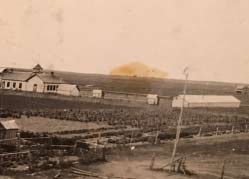
Green Timber School House(taken from Hossner Barn)
Courtesy of Helen Kinler
Special thanks to my editors, my wife Kathryn Kunz Grube, and my youngest son
Austin Keith Grube.
This history of Green Timber, Idaho is only as accurate as the sources’ information.
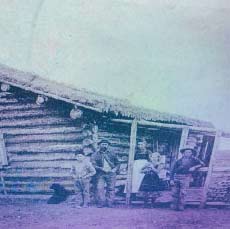
Erpenback Family 1900
William, Anton, Jennie, Unknown, Unknown

First official School house of Green Timber 2019
Courtesy of Grube Family
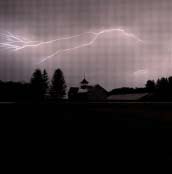
Green Timber School House
Courtesy of Grube Family
